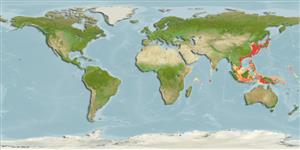Elasmobranquios (tiburones y rayas) (sharks and rays) >
Carcharhiniformes (Ground sharks) >
Triakidae (Houndsharks) > Triakinae
Etymology: Mustelus: Latin for weasel, an ancient name for sharks, possibly referring to the pointed snouts, swift movements and/or rapacious feeding behavior of smaller predatory sharks [strictly not tautonymous with Squalus mustelus Linnaeus 1758 since type was designated by the ICZN]. (See ETYFish); manazo: Japanese vernacular for this shark. (See ETYFish).
More on author: Bleeker.
Environment: milieu / climate zone / depth range / distribution range
Ecología
marino demersal; rango de profundidad 0 - 360 m (Ref. 13563). Tropical; 45°N - 10°S
Western Indian Ocean: Kenya. Western Pacific: southern Siberia, Japan, Korea, China, Taiwan and Viet Nam; Chesterfield Islands (Ref. 11897).
Length at first maturity / Tamaño / Peso / Age
Maturity: Lm 65.0, range 62 - 68 cm
Max length : 220 cm TL macho / no sexado; (Ref. 4883); peso máximo publicado: 5.7 kg (Ref. 40637); edad máxima reportada: 10 años (Ref. 6081)
Found in the intertidal zone, on mud and sand bottom, down to a depth of at least 360 m (Ref. 13563). May also be found in semi-enclosed sea areas (Ref. 11230). Feeds mainly on bottom invertebrates, also bony fishes (Ref. 244). Ovoviviparous (Ref. 50449). Caught regularly by demersal longliners operating both inshore and in deep-water (Ref.58048). Utilized for human consumption (Ref. 244).
Ovoviviparous, embryos feed solely on yolk (Ref. 50449), with 1 to 22 (Ref.58048 reports 5-14)young in a litter. Gestation period takes about 10 months (Ref. 244) or 11-12 months (Ref. 28055). Young born in spring. Distinct pairing with embrace (Ref. 205).
Compagno, L.J.V., 1984. FAO Species Catalogue. Vol. 4. Sharks of the world. An annotated and illustrated catalogue of shark species known to date. Part 2 - Carcharhiniformes. FAO Fish. Synop. 125(4/2):251-655. Rome: FAO. (Ref. 244)
IUCN Red List Status (Ref. 130435)
Threat to humans
Harmless
Human uses
Pesquerías: comercial; pesca deportiva: si
Más información
ColaboradoresImágenesStamps, Coins Misc.SonidosCiguateraVelocidadTipo de nataciónSuperficie branquialOtolitosCerebrosVisión
Herramientas
Special reports
Download XML
Fuentes de Internet
Estimates based on models
Preferred temperature (Ref.
123201): 14.4 - 28.1, mean 23.2 °C (based on 677 cells).
Phylogenetic diversity index (Ref.
82804): PD
50 = 0.5000 [Uniqueness, from 0.5 = low to 2.0 = high].
Bayesian length-weight: a=0.00214 (0.00117 - 0.00391), b=3.13 (2.97 - 3.29), in cm total length, based on LWR estimates for this species & Genus-body shape (Ref.
93245).
Nivel trófico (Ref.
69278): 3.7 ±0.1 se; based on diet studies.
Resiliencia (Ref.
120179): Muy bajo, población duplicada en un tiempo mínimo superior a 14 años (K=0.07; tm=1.9-4; tmax=10; Fec=1).
Fishing Vulnerability (Ref.
59153): High vulnerability (63 of 100).
Nutrients (Ref.
124155): Calcium = 17.6 [5.5, 90.4] mg/100g; Iron = 0.424 [0.128, 1.518] mg/100g; Protein = 21.1 [18.7, 23.4] %; Omega3 = 0.0841 [, ] g/100g; Selenium = 116 [33, 429] μg/100g; VitaminA = 7.92 [2.91, 21.89] μg/100g; Zinc = 0.767 [0.337, 1.566] mg/100g (wet weight);
